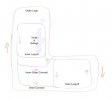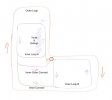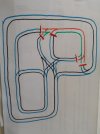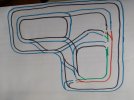This is a rough diagram of my current layout. It consists of

As currently structured, all tracks share a common polarity, and the entire layout can be powered with a single DCC connection.
I'm thinking of replacing the LGB 13200 crossing with an LGB 12260 double slip crossing. This would allow me to run trains onto and off the two loops in either direction. However, it plays havoc with the polarity.

Plan would be to run the inner and outer loops with the same polarity (e.g. clockwise), and use reversing sections at the interchanges. This would also allow me to add additional (non-reversing) interchanges between the inner and outer loops.
Question: where do I put the reversing sections for optimal operation?
- an outer mainline loop (green)
- two inner loops (purple) that can be joined into a single large inner loop (green)
- two connections to allow trains to pass between the outer and inner loops (pink)

As currently structured, all tracks share a common polarity, and the entire layout can be powered with a single DCC connection.
I'm thinking of replacing the LGB 13200 crossing with an LGB 12260 double slip crossing. This would allow me to run trains onto and off the two loops in either direction. However, it plays havoc with the polarity.

Plan would be to run the inner and outer loops with the same polarity (e.g. clockwise), and use reversing sections at the interchanges. This would also allow me to add additional (non-reversing) interchanges between the inner and outer loops.
Question: where do I put the reversing sections for optimal operation?


